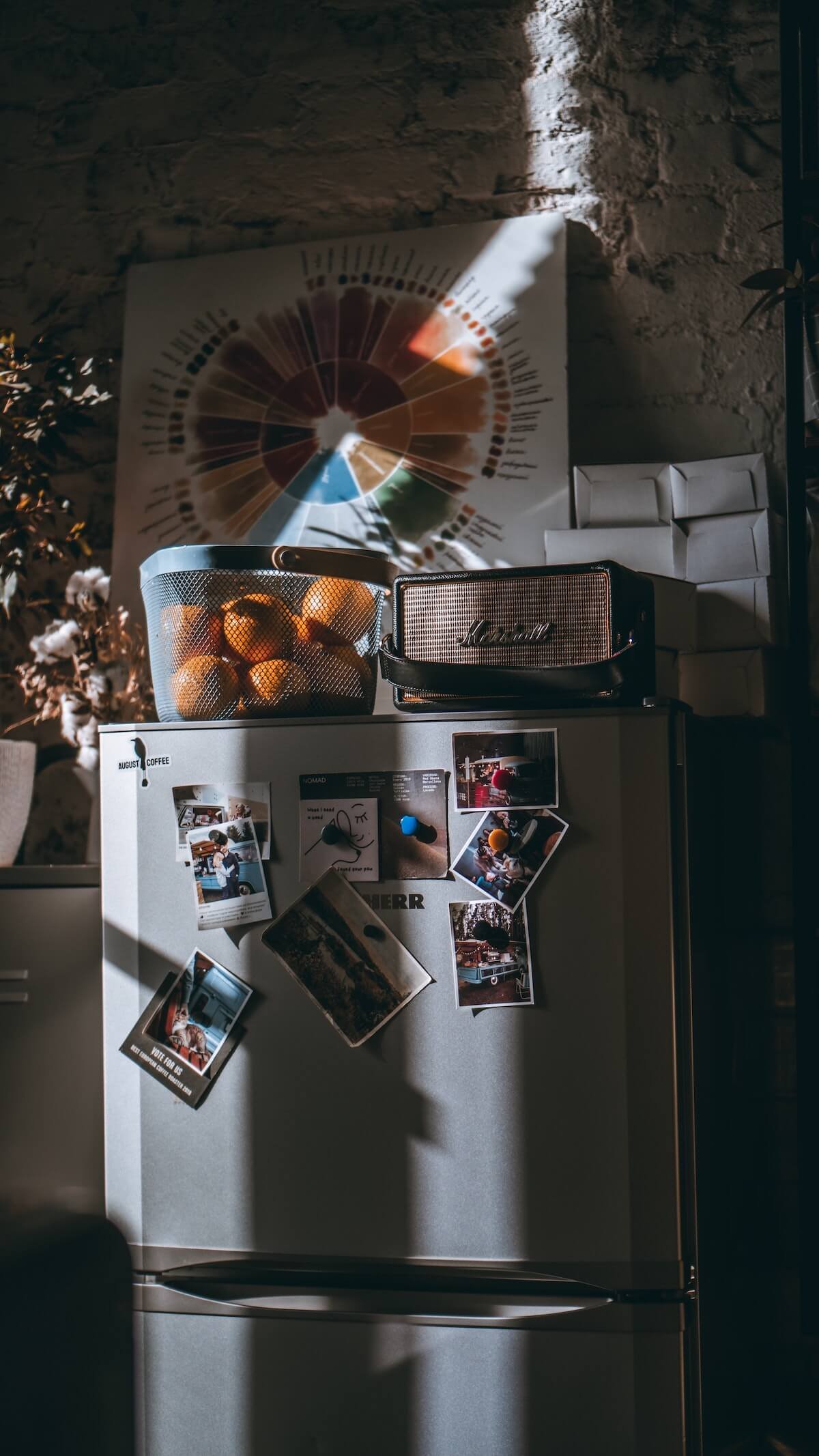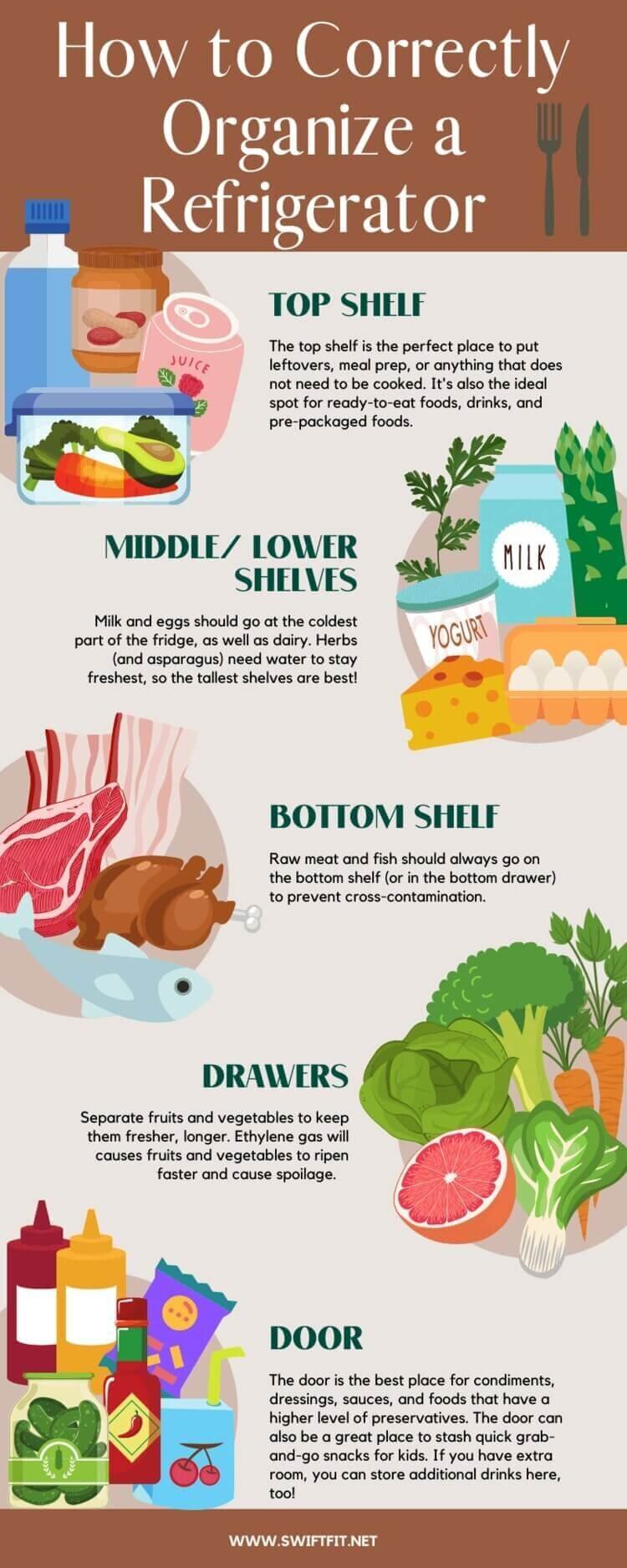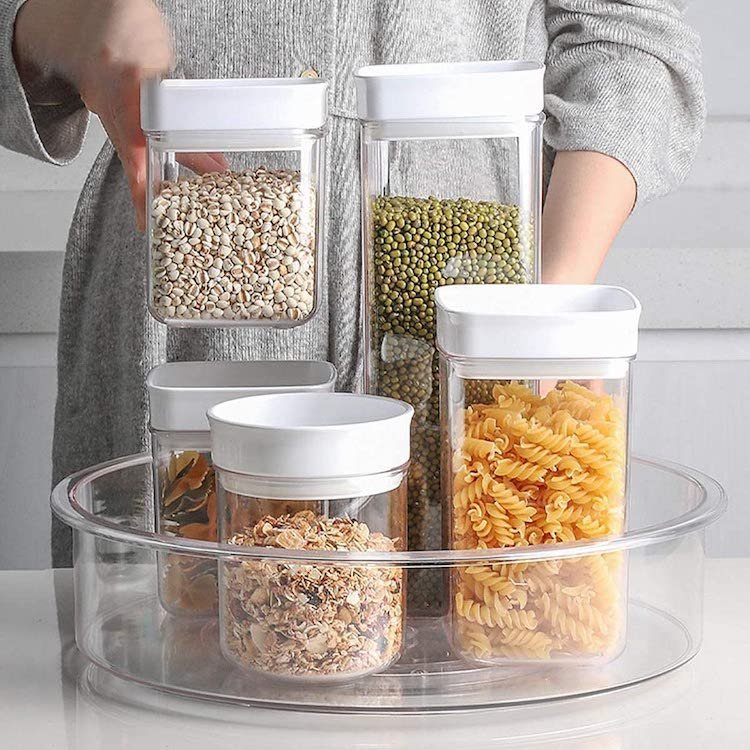18 Fridge Storage Solutions To Stop Wasting Expensive Groceries
This page may contain affiliate links. We may earn a small commission for any purchases made through these links. Click here for the disclosure statement.
When was the last time that you thought about refrigerator organization? What about the last time you cleaned out those refrigerator drawers? If you answered, “I can’t remember,” you are not alone. In fact, refrigerators continue to get larger, advertising more storage or larger freezer drawers. But is it possible that your problem is not the size of your refrigerator, but the organization itself? No matter the amount of fridge storage, these fridge organization ideas are guaranteed to help you maximize use and minimize waste.
Grocery Food waste each year
Sure, you store your extra meat in the freezer and buy canned fruits and vegetables. You buy dried goods in bulk and you rarely throw out uneaten cereal. Even if you think that you don’t waste that much food, here are some staggering numbers for you.
Just How Much Food Is Wasted Each Year?
More than 40 million tons of food are disposed of each year by Americans alone, the most of any country on the entire planet. This is roughly 219 pounds of food waste per person, at a cost of $1,600 for the average-sized American family (and this isn’t even taking recent inflation prices into account). Just think what you could do with an extra $1,600 each year!
The 3 biggest reasons for Food Waste
Most of us can agree that we don’t buy food with the intention of throwing it out. Whether it be an ill-fated recipe or an extra ingredient, one way or the other, these food products find their way into the trash. Or, they live in the bottom of your fridge until a nasty odor reminds you that they’re still there.
Buying Too mUch
Easily one of the most common causes of food waste is buying too much. While buying in bulk could save you pennies at checkout, food that finds its way into the trash can or compost pile is costing you dollars in food waste. Even though buying food in large quantities can be the better deal, the average consumer will save money when only buying the measurements that they need. Most commonly, this refers to fresh fruits and vegetables, as well as other raw ingredients that do not freeze and reheat well.
The same can be true when buying frozen food or extra food to freeze until needed. While a freezer is a great storage option for extra food, items cannot be stored here indefinitely. The longer the food remains in the freezer, the less likely you are to eat it and the more likely that it will have freezer burn when you do pull it out.
Tip: When storing food in your freezer, such as leftover meals or fresh meat, write the date on the packaging. Unless you plan to use these items immediately, put any new frozen items at the bottom or back of the freezer, bringing older items to the front. By rotating the frozen items, it ensures that new items do not get used while older items remain in the freezer.
Another reason? Shopping hungry. According to recent research, consumers who shopped while hungry spent 60% more than their non-hungry counterparts, regardless of whether the product was food related or not.
Avoid buying too much when you go shopping by creating a grocery list before you go, including any new ingredients you may need for upcoming recipes. Avoid going to the grocery store in the early morning or late afternoon, to not only avoid the busiest shopping hours, but to avoid being hungry as well.
Lack of Refrigerator Organization
Lack of refrigerator organization can also lead to buying too much food. If shelves are unorganized or food often gets “lost,” you will likely find yourself buying a replacement item. Forgotten food items, specifically produce, will over ripen and become mushy before you are ever able to use it. Leave it too long and you may find yourself with a science experiment growing in the back corners of your refrigerator.
Improper Storage
Have you ever had avocados become too ripe immediately after bringing them home? Reached for an egg and found that it was completely frozen? Improper storage, in particular refrigerator storage, is often a leading cause of food waste. Making sure that you are storing foods at their optimal temperature can help prevent throwing out damaged food.
How to Organize A Fridge
Starting from the top down, there can be a way to efficiently store items in the refrigerator that not only optimizes space, but groups food together based on use and convenience. This ensures that food is kept at the optimal temperatures, minimizes cross-contamination, and prevents unwanted food waste. Ultimately, the best organization will be one that fits your family’s needs, but these guidelines can help you to store food and keep it fresher longer.
Note: While there might be a best practice way to organize your fridge, this doesn’t mean that a different organizational structure that works for you and your family is wrong (well, except for storing raw meat on top of fresh vegetables, that is). These are simply recommended guidelines.
Top shelf
Since the top shelf is not one of the coldest areas of the fridge, it is the best place to store already cooked foods, such as leftovers or meal prep, and ready-to-eat foods. It can also be a great place to store items with a longer shelf life or beverages, such as soda or water.
Middle shelf
The middle shelf can be an extension of the top shelf—if there is not enough room for pre-cooked foods or leftovers—or a great place to put raw ingredients (except meat!) that you are using for an upcoming recipe. Since this shelf is at eye-level, it can be a good place to store snacks and grab-and-go foods that may be more accessible on a lower shelf. Additional items, such as fresh herbs, stay freshest when kept with cut ends submerged in water, so a taller middle shelf would be an ideal storage space.
Note: Always keep cooked foods away from raw ingredients to prevent cross-contamination.
The Lower Shelves
The lower shelves are among the colder compartments of the fridge. Contrary to popular belief, dairy items should not go in the refrigerator door. Opening and closing the door of the refrigerator can create an inconsistent temperature. Instead, eggs and milk, especially, should be stored in an area of the fridge that maintains a constant temperature. Store dairy products—yogurt, cheese, and even butter—in convenient fridge storage containers to be able to access easily. Place milk at the back of the shelf to ensure that it stays at the proper temperature.
drawers
One of the biggest causes of food waste is improper storage in the crisper, or pullout, fridge drawers. A general rule is to keep fruits and vegetables stored separately, but to prevent inadvertent spoilage, there are a few additional steps that you can take.
Know Which Humidity Settings to Use
Most crisper drawers have a humidity setting. Fruits often do best in low humidity, and vegetables, specific leafy greens, do best in high humidity. For this reason, you often see fresh vegetables being sprayed with mist at grocery stores, while fruits are often kept separately at room temperature.
Know When to Separate Specific Fruits and Vegetables
Best practice is to separate fruits from veggies due to the production of ethylene gas. This gas is emitted from fruits (and some vegetables), causing quicker ripening when stored together.
This includes fruits and veggies that emit ethylene gas. Ethylene gas emits from certain fruits (and some vegetables) and it causes many foods to ripen and expire faster. However, not all fruits or vegetables produce ethylene gas at the same rate.
Fruits that produce high amounts of ethylene gas are best stored alone. These items are also commonly left out of the fridge entirely and stored on the countertop instead. This includes produce such as:
Apples
Avocados
Bananas
Kiwis
Melons
Onions
Peaches
Pears
Plums
Tomatoes
Fruits such as avocados, mangos, kiwis, and apricots can be ripened on the counter and then refrigerated to extend freshness.
Bottom Shelf
The bottom shelf (or drawer) should be reserved exclusively for meat and fish. This is one of the coldest areas of the fridge. However, storing uncooked meat below all other ingredients ensures that there is no cross-contamination. While this may not be possible in all fridge designs, raw meat, fish, or poultry should never be stored above cooked or ready-to-eat food. To prevent any additional contamination, it is important to store meat in resealable bags and fridge storage containers to prevent spillage or leakage.
In The Door
Since the door can be one of the warmest places in the fridge, this is the perfect location to store less-perishable items, such as condiments, sauces, or processed foods. This can also be an optimal spot for any additional beverage cans or bottles.
Tip: The refrigerator door can also be a convenient area to make a snack zone for small children. Ready-to-eat foods, individually sized snacks, or small drink containers, can be kept here for easy access.
18 Products for Easy Fridge Organization
Many refrigerators now offer adjustable shelving that can be customized to fit your needs. Take advantage of the flexibility to use these creative storage options to optimize storage and function.
Amazon
Lazy Susan Turntables
Have items that you need to reach frequently? These rotating options allow you to quickly and easily find common ingredients and packaging. Plus, they come with a mat that prevents items from sliding around and is removable for easy cleanup.
Amazon
Egg Tray Holder
When you bring home your groceries from the store, making sure that the eggs remain unbroken is generally the number one priority. Why shouldn’t keeping them safe in the refrigerator be, too? This organizer not only keeps your eggs safe and sound, but it allows you to stack other food items on top, optimizing your space!
Amazon
Hanging Baskets and Hooks
Vertical space is often wasted in many refrigerators when shelves are adjusted to accommodate taller items. Instead of leaving this space empty, use hanging clips and hooks for bagged produce or prepackaged items. You can also use hanging baskets which conveniently attach to the bottom of a higher shelf to maximize storage.
Amazon
Stackable Storage Containers
Stackable refrigerator storage bins can allow you to place items on top of each other, with convenient pullout drawers for easy access. These fridge bins can also be used to store additional fruits and vegetables, allowing you to separate your uncooked meat with ease.
Bonus: These stackable containers have built-in colanders that allow you to wash produce and allow any excess water to drain away to prevent spoilage.
Amazon
Herb Savers
Sick of your fresh herbs going bad before you are able to use them? The best way to store fresh herbs in your refrigerator is by treating them as you would a flower bouquet! Cut fresh enough on your herbs and stand them straight up, with the ends in water. And of course, don’t put your herb saver to close to the back or top of the refrigerator to prevent freezing!
Amazon
Soda Can Organizer
If you’re a fan of soda, or other canned beverages, you know that they can take up an unnecessary amount of room in your fridge. Leave them in a cardboard container? Good luck seeing how many are left! This organizer is made out of hard plastic, making beverages easy to grab, easy to refill, and easy to enjoy!
Amazon
Bottle & Can Organizer
If you find that your beverages more frequently come in bottles, a soda can organizer will not fit your organizational needs. This shelf can be used for taller bottles and cans, as well as traditionally sized cans.
Amazon
ZipTop Silicone Containers
When it comes to keeping an organized fridge, we love these silicone fridge containers for multiple uses. Not only are they sustainable, easy meal prep containers, but they are also flexible fridge organization ideas that can stand on their own or be placed into the freezer, all while keeping your food fresh!
Amazon
Silicone Food Huggers
Only use half an onion? Is there leftover fruit from snack time? These reusable food “huggers” might look unusual at first, but they are the ideal solution when you don’t want to use a large container for a small item. Even more importantly, produce that is prone to drying out—such as citrus fruits—will be preserved longer than in standard containers, ensuring that even the smallest item doesn’t go to waste!
Bonus: These food savers can act as leakproof lids for cans and jars that might not otherwise be reusable, saving you time and preventing you from having to transfer food into a separate container.
Amazon
Airtight Glass Containers
Remove food from its outer packaging to make it more readily visible when opening your refrigerator. Glass storage containers can also be useful for meal prep, leftovers, or washed and chopped vegetables. Glass jars can also be an efficient storage option for soup or homemade drink options. Both are easy, eco-friendly ways to go green at home. Even better, the airtight seal on these glass meal prep containers means food stays fresher, longer!
Amazon
Refrigerator Storage Bins With Lids
A wide array of organizer bins exist to fit your every day. Using clear containers allows you to sort items based on food group, use, or frequently used items. Clear bins also make it easier to see labels and identify when you need to purchase more of a specific item. Plus, many of these organizer bins come in heavy duty options, to fit a huge array of food.
Amazon
Divided Snack Bins
Another easy option for your fridge (or pantry) are these divided snack bins. They create easy grab-and-go containers for pre-portioned or individually packed snacks. Perfect for when you are in a hurry!
Bonus: Use these in your pantry to storage single-serving chips, granola bars, or snack packs.
Amazon
XL Food Storage Containers
While these containers don’t have lids, they are a large capacity container that can be used to storage larger items for later use.
Amazon
Drawer Organizers
If your crisper drawers often become an unrecognizable mess of produce, using dividers allow you to sort fruits and vegetables by type. It helps keep items organized and prevents food waste from lost items. Not only is bamboo an incredibly durable material, but it is also sustainable, too!
Amazon
Washable Mats
Keep your refrigerator organized and clean by placing washable silicone mats on each shelf, as well as in any bin or organizer. Not only does it prevent cross-contamination and early spoilage, it makes your fridge even easier to clean! Plus, many of these mats can be cut to size, making them perfect for pantries, cabinets, and drawers throughout your entire kitchen.
Amazon
Door Organizers
Just like the shelves, use door dividers to separate dressings, sauces, and syrups into convenient bins. Use labels to easily identify the various shelves for quick accessibility.
Amazon
Minimalistic Jar Labels
All fridge organization would be for naught without labels to cement all of your hard work. Use these labels on your food storage containers, shelving units, or on your door to identify food without having to open each individual section looking for an item. This is also a crucial step if you are removing outside packaging.
Tip: Label storage containers with their contents. Label individual items with their open or prepared date to make sure that items are eaten and used before their expiration date.
Amazon
Dry Erase Magnetic Labels
For a reusable option, these dry erase labels can be cut to any size that you want and attached with a strong magnet. When you need to change the label, simply erase and start again.
Bonus: These can double as a useful scheduling tool for weekly family dinners when combined with a wall calendar!
























